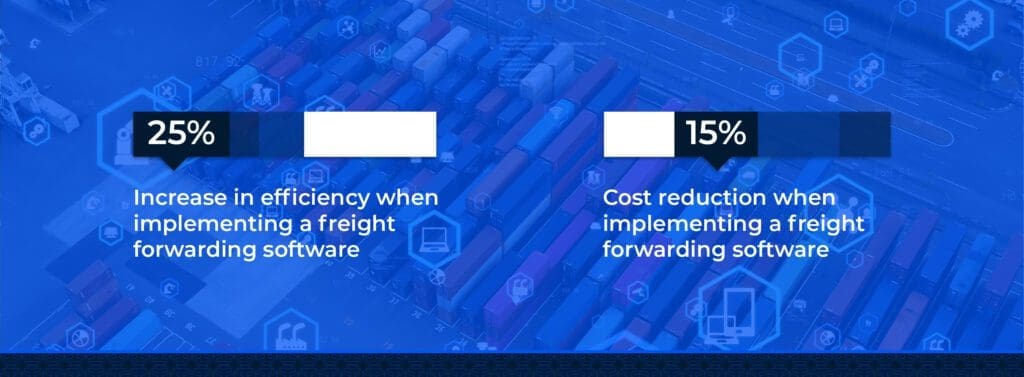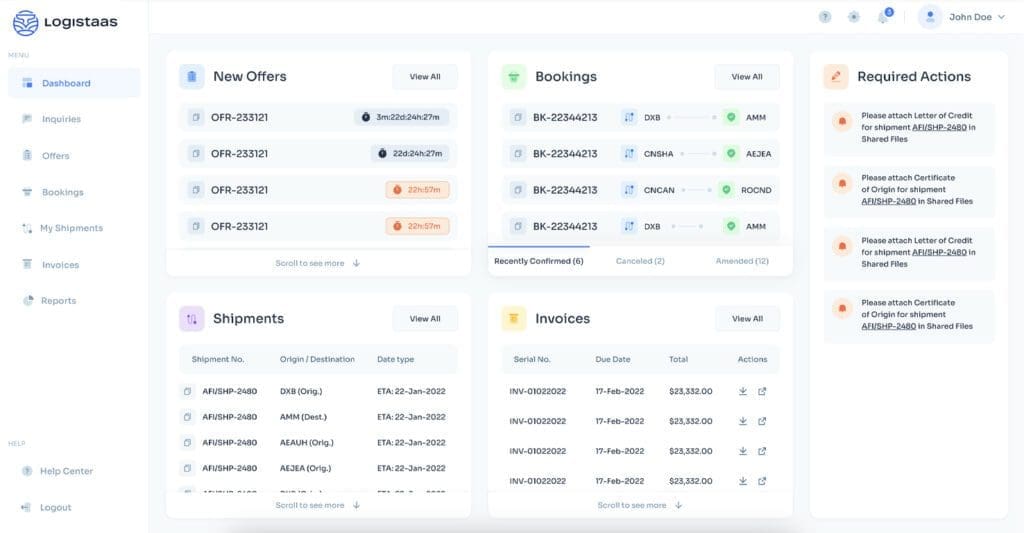
Published Oct 2023
In today’s interconnected global economy, the efficient movement of goods has become the lifeblood of trade and commerce. From the raw materials used in manufacturing to the finished products on store shelves, logistics plays a pivotal role in ensuring that goods reach their destinations in a timely and cost-effective manner.
The logistics industry has undergone a remarkable transformation in recent years, driven by the relentless advancement of technology. Technological innovations have reshaped how goods are transported, managed, and delivered. This intersection of technology and logistics has paved the way for remarkable improvements in efficiency, transparency, and customer satisfaction.
One such advancement is freight forwarding software. It supports freight forwarders who exist at the heart of this intricate web of logistics. Freight forwarding is a crucial link in the supply chain, responsible for coordinating the movement of goods from point A to point B, often across international borders. This profession is tasked with navigating complex customs regulations, coordinating transportation modes, and optimizing routes to ensure that shipments reach their destinations seamlessly.
In this comprehensive article, we aim to unravel the intricacies of freight forwarding software. We’ll explore what freight forwarding is, the evolution of technology within the logistics industry, and the pivotal role that software solutions play in streamlining freight forwarding operations. By the end of this post, you’ll have a deep understanding of the subject and be equipped with insights into the benefits, challenges, and future trends in the world of freight forwarding software.
Section 1: Understanding Freight Forwarding
1.1 Freight Forwarding and Its Key Components

Freight forwarding is a pivotal link in the global supply chain that involves the coordination and management of the transportation of goods from their point of origin to their final destination. It serves as a bridge between shippers and carriers, ensuring that goods are moved efficiently and smoothly across international borders and various modes of transportation. Key components of freight forwarding include:
- Documentation: Managing the extensive paperwork required for international shipping, including customs forms, bills of lading, and export/import documentation.
- Carrier Selection: Choosing the most suitable carriers, such as airlines, shipping lines, trucking companies, or railways, based on cost, speed, and reliability.
- Route Optimization: Determining the most efficient transportation routes, considering factors like distance, transit times, and potential obstacles.
- Customs Compliance: Ensuring that shipments comply with customs regulations, including tariff classifications, duties, and import/export restrictions.
- Cargo Consolidation: Combining multiple smaller shipments into a single larger one to optimize shipping costs and reduce transit times.
1.2 The Role of a Freight Forwarder in the Supply Chain
Freight forwarders act as intermediaries between shippers (exporters or importers) and transportation providers (carriers). Their primary role is to simplify and streamline the complex logistics of moving goods across borders and various transportation modes. They play a crucial role in the supply chain by:
- Booking Cargo Space: Negotiating and booking cargo space with carriers on behalf of shippers to secure the most favorable rates and schedules.
- Documentation and Compliance: Handling the extensive paperwork required for international shipping and ensuring compliance with customs regulations.
- Cargo Tracking: Providing real-time tracking and visibility of shipments, allowing shippers to monitor the status and location of their goods.
- Risk Management: Mitigating risks associated with transportation, including damage, loss, or delays, and providing insurance options when necessary.
- Problem Resolution: Addressing any issues or disruptions that may occur during the shipping process, such as customs delays or unforeseen obstacles.
1.3 The Challenges and Complexities in the Freight Forwarding Process
Freight forwarding is a multifaceted process that faces several challenges and complexities, including:
- Regulatory Hurdles: Navigating the intricate web of international trade regulations and customs procedures, which can vary widely from one country to another.
- Multimodal Transportation: Coordinating the movement of goods across different modes of transportation, such as air, sea, road, and rail, often involving multiple carriers.
- Supply Chain Disruptions: Adapting to unexpected disruptions, such as natural disasters, labor strikes, political unrest, or pandemics like COVID19 in 2020 that can impact the flow of goods.
- Data Management: Handling vast amounts of data related to shipments, customs documentation, and tracking information while maintaining accuracy and security.
- Customer Expectations: Meeting the evolving expectations of customers who demand real-time visibility, faster delivery times, and seamless communication.
Section 2: The Evolution of Freight Forwarding Software
2.1 Historical Development of Freight Forwarding Software
The evolution of freight forwarding software is a testament to the ever-increasing complexity of global trade and the need for streamlined logistics solutions. Historically, freight forwarding was a labor-intensive process involving manual paperwork, phone calls, and physical coordination. This analog approach, while effective in its time, was prone to errors and delays.
The advent of computer technology in the mid-20th century marked the first significant step in the automation of logistics. Early freight forwarding software systems emerged to handle basic tasks like record-keeping and documentation. These early systems, however, lacked the sophistication and connectivity required for modern global trade.
Over the decades, as technology advanced, so did freight forwarding software. The rise of the internet and digital communication in the late 20th century paved the way for the development of cloud-based solutions. These systems offered real-time tracking, automated document management, and streamlined communication between stakeholders.
2.2 How Technology Has Transformed the Logistics Industry
In a rapidly evolving logistics landscape, digital freight forwarders are redefining the industry. As global trade expands and supply chains grow complex, the need for efficiency and transparency has never been greater. This has given birth to digital forwarders who leverage technology to optimize operations and enhance customer experiences.
Digital forwarders leverage digitization to:
- Enhance Customer Experience: Real-time tracking, accurate pricing, and streamlined bookings empower forwarders to provide clients with up-to-date information, leading to better decision-making.
- Boost Operational Efficiency: Digitization optimizes processes, reducing manual tasks, and resulting in quicker turnaround times and cost savings.
- Gain Data-Driven Insights: Real-time data allows forwarders to understand shipment patterns, transit times, and potential bottlenecks, which can be used for predictive analytics.
- Encourage Collaborative Innovation: Forwarders and carriers can collaborate on technological innovations like blockchain applications for enhanced supply chain transparency and security.
2.3 Benefits of Adopting Freight Forwarding Software
The adoption of modern freight forwarding software offers several key benefits:

- Efficiency: Software automates time-consuming tasks, reducing manual errors and processing time.
- Cost Reduction: By optimizing routes, minimizing delays, and automating processes, businesses can cut operational costs.
- Transparency: Stakeholders gain real-time visibility into shipments, fostering transparency and improving customer service.
- Competitive Advantage: Companies that leverage technology can offer faster, more reliable services, gaining a competitive edge in the market.
- Scalability: Freight forwarding software can scale with a business’s growth, accommodating increased shipments and complexity.
Section 3: Logistaas and Key Features of Freight Forwarding Software
3.1: Logistaas Features and Functionalities

Logistaas is an exemplary freight-forwarding software solution that encompasses a wide array of features. It stands out in the market for its user-friendly interface, scalability, and robust capabilities. Logistaas exemplifies how modern freight forwarding software solutions can enhance efficiency, accuracy, and transparency in the logistics industry. It’s an excellent choice for businesses looking to streamline their freight forwarding operations and stay competitive in today’s global marketplace.
Here are some of the essential features and functionalities of Logistaas:
- Sales and Pricing Management: Logistaas offers a CRM module designed exclusively for freight professionals, streamlining sales, pricing, and quotation processes.
- Operations Management: Seamlessly connect with carriers, automate document generation, access dynamic reports, and more within a single platform.
- Finance Management: Simplify financial management with precise accounts tracking, efficient invoicing, and seamless integration. Gain insight through dynamic profit reports—all within one platform.
- Online Customer Portal: Empower freight forwarders to join the digital era with a modern, branded online portal that streamlines inquiries, quotations, bookings, shipment tracking, and more.
- Integrations: Logistaas emphasizes integrations, allowing seamless connections with various supply chain partners, accounting software, local customs, exchange rates, and e-invoicing.
- Efficient Document Management: Logistaas automates document generation and management, simplifying paperwork associated with international shipping.
- Billing and Invoicing: Streamlines billing and invoicing processes, enabling accurate and efficient financial transactions.
3.2 Benefits of Using Logistaas’s Freight Forwarding Software
The adoption of Logistaas offers numerous advantages. Here are some of them:
- Cost Savings: Freight forwarding software optimizes routes, selects cost-effective carriers, and reduces manual paperwork, resulting in significant cost savings over time.
- Efficiency Improvements: Automated processes and real-time tracking enhance workflow efficiency, allowing businesses to handle a higher volume of shipments with fewer resources.
- Reduced Errors: Automation reduces the risk of human errors in documentation, data entry, and communication, improving the accuracy and reliability of shipments.
- Enhanced Customer Service: Providing customers with real-time tracking and transparency builds trust and improves overall customer satisfaction.
- Strategic Insights: Data analytics tools within freight forwarding software can offer valuable insights into supply chain performance, helping businesses make data-driven decisions and optimize their operations.
To start leveraging the many benefits of Logistaas, you can book a demo here.
Section 4: How Freight Forwarding Software Works
4.1 Workflow of Freight Forwarding Software
Freight forwarding software is the backbone of efficient logistics operations, streamlining the complex process of moving goods from origin to destination. Here’s a step-by-step walkthrough of its typical workflow:
- Shipment Initiation: The process begins when a freight forwarder initiates a new shipment within the software. They provide essential details such as shipment type, destination, and cargo specifics.
- Document Preparation: The software automates the generation and management of extensive documentation required for international shipping. This includes bills of lading, customs forms, and commercial invoices.
- Booking Cargo Space: The software facilitates the booking of cargo space with selected carriers. It supports the reservation and communication of shipment details to carriers.
- Customs Compliance: The software ensures that shipments comply with customs regulations. Through various integrations with customs and banks across the world.
- Data Analytics: Data analytics tools analyze various data points, providing insights into supply chain performance. These insights help logistics companies make data-driven decisions, optimize routes, and predict demand.
Logistaas stands out with its unique features, offering seamless integrations with carriers, customs, and tax authorities, empowering data-driven decision-making through advanced analytics, and providing an intuitive user experience that simplifies complex logistics processes. It distinguishes itself by offering a customer portal that enhances client engagement and transparency, allowing customers to access real-time shipment information. Moreover, our integrated CRM system enables efficient customer relationship management, ensuring personalized interactions and delivering a superior client experience. With Logistaas, you gain a competitive edge in the freight forwarding industry, streamlining operations and delivering unparalleled efficiency.
4.2 Automation and Data Analytics
Automation is a core feature of freight forwarding software. It reduces manual tasks, minimizes errors, and accelerates processes. Automation also enables proactive issue resolution, reducing shipment delays.
Data analytics within the software analyze vast amounts of data, allowing logistics companies to make informed decisions. Freight forwarding software’s ability to automate, integrate, and provide data-driven insights is instrumental in modernizing the logistics industry, making it more efficient and responsive to the demands of global trade.
Section 5: Challenges and Future Trends

5.1 Challenges in Implementing Freight Forwarding Software
Implementing freight forwarding software, while promising significant benefits, is not without its challenges. Some common obstacles include:
- Integration Complexity: Integrating the software with existing systems and processes can be complex and time-consuming. Compatibility issues may arise, requiring careful planning and execution.
- Data Security: Handling sensitive shipment and customer data necessitates robust security measures to protect against data breaches and cyberattacks.
- Training and Adoption: Training employees to effectively use the software and ensuring widespread adoption across the organization can be challenging. Resistance to change is common and must be managed.
- Initial Investment: The initial investment in software implementation can be substantial depending on the software you choose to invest in. Smaller logistics companies may face financial constraints in acquiring advanced solutions.
Logistaas, as a comprehensive freight forwarding software, offers solutions to these common challenges in the following ways:
- Integration Simplified: Logistaas prioritizes integration and offers a user-friendly interface that connects seamlessly with existing systems. Its modular design allows you to choose specific functionalities to integrate gradually, reducing complexity and minimizing disruption to ongoing operations.
- Robust Data Security: Logistaas understands the importance of data security in the logistics industry. The software is equipped with state-of-the-art security measures, including encryption, access controls, and regular security updates, to safeguard sensitive shipment and customer data.
- User-Friendly Design: Logistaas places a strong emphasis on user-friendliness. Its intuitive interface and ease of navigation make it user-friendly, reducing the learning curve for employees. Training resources and support are readily available to ensure smooth adoption.
- Scalable Pricing: Logistaas offers flexible pricing plans, including a starting price as low as $55 per user per month. This scalability allows both large and small logistics companies to access advanced solutions that match their budget and requirements.
- Dedicated Customer Support: Logistaas provides dedicated customer support and training resources to assist with software implementation and ongoing usage. Their team is available to address any questions or concerns, ensuring a positive experience for users.
5.2 Emerging Trends in Logistics Technology
The logistics technology landscape is continuously evolving, with several emerging trends shaping the industry:
- Artificial Intelligence (AI) and Machine Learning: AI and machine learning are being used for demand forecasting, predictive maintenance, and route optimization. These technologies enhance decision-making and efficiency.
- Blockchain: Blockchain is gaining traction for its potential to enhance transparency, traceability, and security in supply chains. It helps verify the authenticity of products and streamline documentation.
- Internet of Things (IoT): IoT devices, such as sensors and trackers, provide real-time data on shipments, enabling proactive issue resolution and precise monitoring.
- Green Logistics: Sustainable practices are becoming a priority. Electric and autonomous vehicles, as well as alternative fuels, are being adopted to reduce the environmental impact of logistics operations.
5.3 The Future of Freight Forwarding Software
The future of freight forwarding software is poised for further transformation. We can expect:
- Greater Automation: Automation will extend to more aspects of logistics operations, reducing manual intervention and errors.
- Enhanced Integration: Seamless integration with IoT, AI, and blockchain technologies will become standard, offering unprecedented visibility and efficiency.
- Data-Driven Decision-Making: Advanced data analytics will drive strategic decision-making, optimizing routes, inventory management, and demand forecasting.
- Customization and Scalability: Software solutions will offer greater customization options and scalability to cater to businesses of all sizes.
- Environmental Sustainability: Freight forwarding software will increasingly focus on sustainability, with tools to minimize carbon footprints and support green logistics practices.
As freight forwarding software continues to evolve, it will play a pivotal role in shaping the future of global trade and logistics, addressing challenges and capitalizing on emerging trends to drive efficiency, transparency, and sustainability. While they grow Logistaas will grow too and will create a future for logistics like no other.
Final Thoughts:
In today’s fast-paced global economy, the importance of efficient logistics cannot be stressed enough. Freight forwarding software’s such as Logistaas has emerged as a game-changer in this landscape, streamlining operations, enhancing transparency, and driving competitiveness.
Key takeaways from this blog post include the profound impact of freight forwarding software in reducing costs, improving efficiency, and boosting customer satisfaction. It catalyzes change, automating complex processes, and providing invaluable data-driven insights.
As the logistics technology landscape evolves, embracing emerging trends such as AI, blockchain, and IoT becomes essential. The future of freight forwarding software promises greater automation, sustainability, and scalability.
In closing, we encourage logistics professionals to explore and adopt technology solutions like freight forwarding software. It’s not just a tool; it’s a strategic investment that will propel your business forward in the dynamic and interconnected world of modern logistics. Embrace the future, optimize your operations, and stay competitive in the ever-evolving global marketplace.

